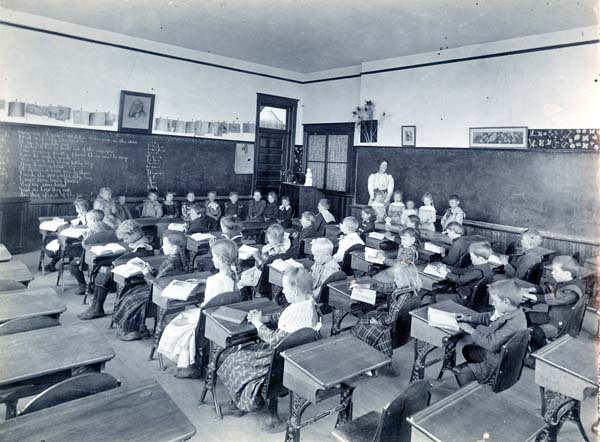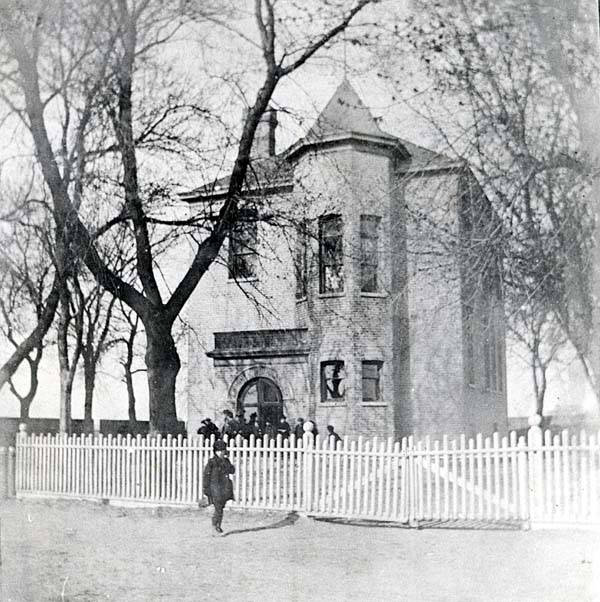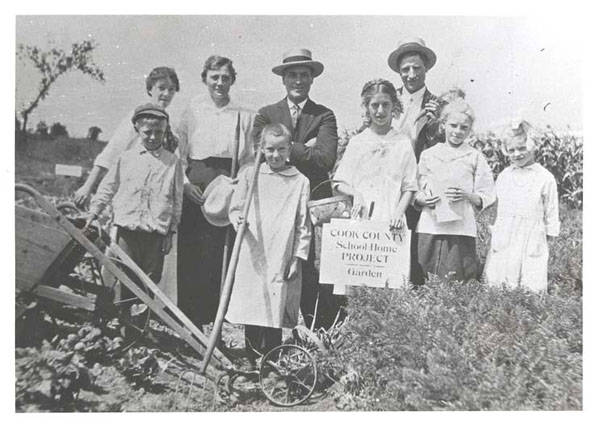9 Education and Schools
FORMAL EDUCATION in Skokie dates back to the days before the Civil War, and some 30 years before the village was incorporated. The original Fairview School, the village’s first, was constructed in 1858, the same year that Henry Harms opened the first store in the settlement that would one day become known as Skokie.
For most of the area’s early pioneers, schooling ended in the elementary grades. Simply getting to a high school in the second half of the nineteenth century was a chore indeed. Alma Klehm, one of the earliest Niles Center settlers to attend high school, described a commute that required a walk or bicycle ride to the Morton Grove railroad station and then a train ride to the Mayfair High School in Chicago.
Six elementary schools were operating within the present boundaries of the village by the time high school classes were inaugurated in Niles Center in 1931. Initially they were held in the Lincoln Elementary School. The building that became known as Niles Township East, and served as the township’s first high school, was not dedicated until 1939.
The population explosion of the 1950s and 1960s brought about the need for new schools. Two new high school buildings were built, Niles Township West, in 1958, and Nile Township North, a few years later. A number of new elementary schools also opened their doors during those two decades.
After 1970, however, the phenomenal growth in enrollment in area schools came to a gradual halt. The lack of undeveloped land for new construction, the maturing of the post-war baby boom generation, as well as decisions to emphasize single family homes over apartments in the village, led to declining school enrollments and a number of school closings. Historic Niles Township East was closed in 1975, eventually serving as the home for Centre East as well as the Skokie campus of Oakton Community College. Sharp Corner and College Hill elementary schools were closed in 1976. Cleveland and Kenton were subsequently closed, and Fairview North elementary school closed in June 1988.
Despite the fact that the village has fewer public schools than it had in the 1960s and early 1970s, there is no less emphasis on quality education for all school-age residents. Year after year, in fact, studies show that Skokie’s schools outperform state and national averages by wide margins.
Elementary Schools
By mid-1988, a dozen elementary and junior high schools, organized within six school districts, were serving the village of Skokie. The chart entitled “Skokie Elementary Schools” summarizes this organization. Since school districts do not necessarily follow township and municipal borders, only three of the village’s six elementary school districts are entirely within the village, the others extending into neighboring communities.
In its annual report card issued for public schools throughout the state, the Illinois government assessment of elementary school performance, based on standardized test scores, shows that Skokie’s elementary schools far surpass both state and national averages. In the 1987 report, for example, covering the 1985-1986 school year, District 72 could boast of having 55 percent of its sixth graders reading at a level achieved only by 25 percent of students nationwide. Also impressive is the mathematics performance of sixth graders in District 68, on the village’s northwest side. There, nearly 72 percent of the sixth grade students had mathematics skills equal to the top 25 percent of students nationwide.
Skokie school students in every district, in fact, easily outperformed the national averages.
This type of academic excellence does not come without a price, however. In Skokie, as elsewhere, education is a multimillion dollar business. Expenditures during the 1986-1987 school year in District 69, for example, amounted to $5.8 million.
Not surprisingly, Skokie area schools pay their teachers more and spend more money per pupil than in the state and national average. In 1987, for example, per pupil expenditures ranged from a high of $6,947 annually in District 72 to a low of $5,189 for District 65, all substantially above the statewide average of $3,809.
In the 1980s, a new migration to Skokie took place, with large numbers of Asian immigrants moving into the area. All elementary schools in the area have felt the impact of the new arrivals. At the East Prairie School, a full 40 percent of the students enrolled in the 1986-1987 year were of Asian heritage. The private St. Paul Lutheran School had about 25 percent Asian enrollment during the same period.
In addition to the considerable resources of the public elementary school system, Skokie is also served by a number of private parochial schools. The Arie Crown Hebrew School, Hillel Torah North Suburban Day School, and Solomon Schector Day School operate for children of the Jewish faith. St. Paul’s Lutheran Church maintains a Protestant elementary school. And each of the village’s three Catholic churches, St. Peter’s, St. Lambert’s and St. Joan of Arc, offer full eight-year elementary programs.
 Students are hard at work in this 1901 photo inside the Niles Center Public School
Students are hard at work in this 1901 photo inside the Niles Center Public School
 The old Fairview School, the village’s first, which was built in 1858 on the southwest corner of Howard Street and Niles Center Road
The old Fairview School, the village’s first, which was built in 1858 on the southwest corner of Howard Street and Niles Center Road
 The School Garden Club formed by Alma Klehm (third from left) about 1910
The School Garden Club formed by Alma Klehm (third from left) about 1910
High Schools
Most of Skokie’s teenagers attend one of two high schools included in District 219: Niles Township North, with a 1988 enrollment of about 1,630, or Niles Township West, with approximately 1,800 students. Both schools also serve portions of neighboring villages, including Glenview, Golf, Niles, and Morton Grove by Niles North, and Morton Grove, Niles and Lincolnwood by Niles West. Students in elementary District 65 on the northeast side of the village attend Evanston Township High School, long recognized as one of the nation’s finest secondary schools.
A number of statistics point to the overall excellence of the Niles Township high schools. In 1986, for example, District 219 schools were among the top 50 secondary schools in the Midwest in terms of the number of students participating in honors courses, including such subjects as English, computer science, foreign languages, history, physics, and chemistry. Because of the extensive list of advanced placement courses taught at the two schools, a number of graduates are able to enter directly into second-year college courses following graduation from high school. The emphasis on college preparatory study in Niles Township schools enables approximately nine out of 10 students to continue their education, the majority in four-year curricula.
In an era of widespread budget cutbacks and stripped-to-the-basics educational programs, Skokie’s two public high schools have managed to maintain a wide range of extracurricular programs and activities. More than a dozen musical groups are active on the two campuses as well as nearly two dozen athletic programs for both boys and girls. Student publications include two literary magazines and award-winning yearbooks and newspapers. Student-produced stage productions are also a regular feature at both schools.
The intensive and broad nature of academic studies and extracurricular activities in District 219 schools has not, however, produced burdensome tax rates in the village. In 1987, the Cook County Clerk’s Tax Extension Office released a study of the tax rates of the 26 suburban high school districts in the county. The study measured the percentage of local tax bills earmarked for high school districts. Only about 21.5 percent of local tax bills went to Niles Township District 219, a tie with Evergreen Park District 231 for the third lowest spot on the list. The study shows that high educational standards and high tax bills do not necessarily go hand in hand.
Enrollment patterns in District 219 schools, as in the village’s elementary schools, reflect the growing numbers of Asian immigrants in the village. In late 1987, Asians accounted for about 18 percent of the district’s total enrollment, compared to about six percent in Maine Township and New Trier, and 2.5 percent in Evanston Township.
Oakton Community College
Since its start in 1980, Oakton College East, as the full-service Skokie extension campus of Oakton Community College is known, has had a growing impact on the community. During recent terms, an average of 1,500 students have been enrolled in full and part-time programs at the Skokie facility, which is located in the original Niles Township East high school building on Lincoln Avenue.
Oakton Community College was founded in 1969 in Morton Grove. The name was chosen because the school was originally located on Oakton Street. Community college District 535, however, includes the townships of Maine, Niles, New Trier, and a portion of Wheeling.
In less than a decade, the original site at 5600 Oakton proved too small for the college’s growing programs. A site along Golf Road in Des Plaines was selected for a new campus near the western edge of District 535.
A number of Skokie residents felt that the recently abandoned Niles Township East building could serve as an extension campus for the growing school in an area that would be far more convenient for people living in the eastern portion of the district. The Skokie Advisory Committee, composed of a number of school board officials and area homeowners, successfully lobbied at the state capital in Springfield in 1979 to create a Skokie Campus. The new extension campus was renamed Oakton East in 1986.
By 1980, the first phase of construction of the main Des Plaines campus was completed. The year that the college moved its facilities from Morton Grove, about three-fifths of the total resources went to the new Des Plaines campus and the other two-fifths to Skokie’s Niles East. When a second phase of construction was completed in 1983 at the Des Plaines campus, more resources were moved to the main campus. Remaining in Skokie was a smaller, but still complete, extension school.
Like most other community colleges, Oakton’s baccalaureate programs are limited to two years, but are designed so that students desiring a four-year degree can easily transfer to a senior college. Other courses are vocationally oriented, stressing practical skills that can be put to use in a technical career.
The Skokie campus provides courses for college credit in a dozen different general curriculum areas, including traditional liberal arts and business courses as well as a variety of specialized instructional programs.
One of the most extensive programs offered by Oakton Community College is the Maine-Oakton-Niles-Northfield Adult and Continuing Education Program (MONNACEP). Cooperating with area high school districts and coordinating their efforts, the program makes available nearly 8O0~separate courses, ranging from assertiveness training to word processing to Yoga. Courses are taught in area high schools, parks, and other sites scattered throughout the district, some in Skokie.
 Oakton College East on Lincoln Avenue, an extension campus of Oakton Community College, provides two-year college-level education for residents of Skokie and nearby communities
Oakton College East on Lincoln Avenue, an extension campus of Oakton Community College, provides two-year college-level education for residents of Skokie and nearby communities
The Hebrew Theological College
The Hebrew Theological College, which resides today in a complex of buildings at Carpenter and Touhy in Skokie, is one of the major rabbinical training centers in the United States, second only to Yeshiva University in New York.
Originally incorporated in Chicago back in 1922 under the guidance of Rabbi Saul Silber, who served as president until 1946, the college’s first home was in a classically styled building at St. Louis Avenue and Douglas Boulevard on the city’s west side. The college, which essentially had evolved from two smaller schools, had two basic goals, according to its current president and Hebrew scholar Rabbi Don Well: “to provide advanced Jewish education at a high level and to prepare rabbis to serve the Jewish community in the area.”
A library building was added in 1929 to house the college’s nationally-known Academic Torah Library.
The leadership of the college passed to one of its own graduates, Rabbi Oscar Z. Fasman in 1946. During his tenure, which lasted until 1964, a general deterioration of the area of Chicago in which the college was located forced the school’s officials and advisors to seek a new site in the mid-1950s. A 16-acre tract of land in Skokie was purchased in 1957 and three modern buildings were erected on the new campus.
By the time of the move to Skokie, the college had educated and ordained more than 500 rabbis. After the relocation, a secular junior college was added, and later a high school. A Kollel, a post-graduate study group of Jewish scholars who reside on campus for a specified term of study, was instituted in the 1980s.
Under the direction of Rabbi Don Well, who was appointed president in 1981, the Hebrew Theological College presently serves about 300 students.
Skokie’s Wide-Ranging Educational Opportunities
An unusually wide array of educational resources are available to nearly every resident of Skokie. In addition to an outstanding public school system extending from kindergarten through junior college, the village has parochial elementary schools representing each of the three major faiths: Protestant, Catholic, and Jewish. There are also a number of special schools, including Hebrew Theological College, Brisk Rabbinical School, Chinese Language School, and Orchard Village, a residential school for mentally handicapped young adults. The main campus of Northwestern University, a leading institution of higher learning, is located in Evanston just a few miles to the east. And all of the resources of one of the world’s great cities, Chicago, are located at Skokie’s doorstep.
 School Districts 68, 69 and 72 are principally in Skokie but also extend beyond the western boundaries of the village. Much of District 65 is in Evanston, including only those portions of Skokie east of Crawford Avenue and north of Greenleaf Street. (Fairview North closed in June 1988.)
School Districts 68, 69 and 72 are principally in Skokie but also extend beyond the western boundaries of the village. Much of District 65 is in Evanston, including only those portions of Skokie east of Crawford Avenue and north of Greenleaf Street. (Fairview North closed in June 1988.)